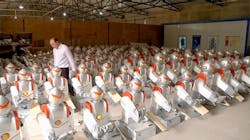So there’s this article that appeared recently in The Atlantic that’s been generating a lot of discussion. The article focuses on a topic that’s pretty old hat for the manufacturing industry, i.e., how automation and robots are taking more and more jobs.
What’s different about The Atlantic’s article is that it points out how automation and robots are moving from replacing low-skilled work to replacing more medium- and high-skilled jobs. For example, the article points out how robots are “already creeping into diagnostics and surgeries. Schools are already experimenting with software that replaces teaching hours. The fact that some industries have been safe from automation for the last three decades doesn't guarantee that they'll be safe for the next one.”
Given that these realities will likely only further stir the pot of problems faced by industry when it comes to finding people who want to work in manufacturing, I wanted to find out how schools that are training people to work in manufacturing deal with this kind of information. After all, more than anyone else, they most likely to get asked by students: Why would I want to work in manufacturing? Aren’t all those jobs going away?
To find out how they deal with this, I turned to my contacts at Tri-County Technical College in Pendleton, S.C. The college is located in an area in which manufacturing has thrived over the past few decades. Some of the local employers they work with to place students include BMW, Borg Warner, Bosch, Michelin, Schneider Electric, and many others.
Shan Smith, program coordinator for Industrial Electronics Technology at Tri-County, says that though automation and robots are eliminating some jobs, they are also creating others. Because of this, Smith prefers to ask: “What jobs will robots create?”
As robots and advanced automated systems are commissioned, the need for advanced workers will follow, Smith contends. “Automation in all areas will continue to drive the demand for quality engineers, mechatronics technicians, PLC technicians, process control technicians, programmers, designers, CNC technicians and engineering graphics technicians, just to name a few.”
“Automation creates a need for more skilled workers who are able to design, build, program, install, troubleshoot and maintain robots and their mechanical cousins,” adds Cheryl Garrison, coordinator of job placement career services at Tri-County. “Two-year institutions like Tri-County Technical College were created to educate and train people for employment to meet the ever-changing demands of industry and to provide a basis for economic growth and development.”
Shifts in employment represented by the increased introduction of automation and robotics is exactly what technical colleges are positioned to respond to, Garrison points out. “It was the technical college system that helped the state of South Carolina transition from a textile/agrarian economy to a thriving environment for high-tech manufacturing,” she says.
In line with this, Garrison adds that Tri-County Technical College continues to “evolve its offerings based on industry needs, environmental scans, and job placement rates. Robots may replace tasks,” she says, “but robots will always need people.”
“Every generation has faced changes due to technological advances,” adds Smith. “The primary question is what must be done to prepare for the coming changes.”
Note: Cheryl Garrison and Shan Smith from Tri-County Technical College, along with Ted Stokes of Schneider Electric and Doug Wilson of Bosch, will be speaking about educating and training the next generation of manufacturing engineers and operators at The Automation Conference 2014. To learn more about and register for the conference, visit www.theautomationconference.com.

